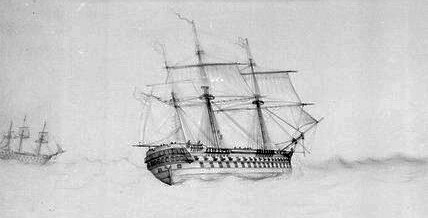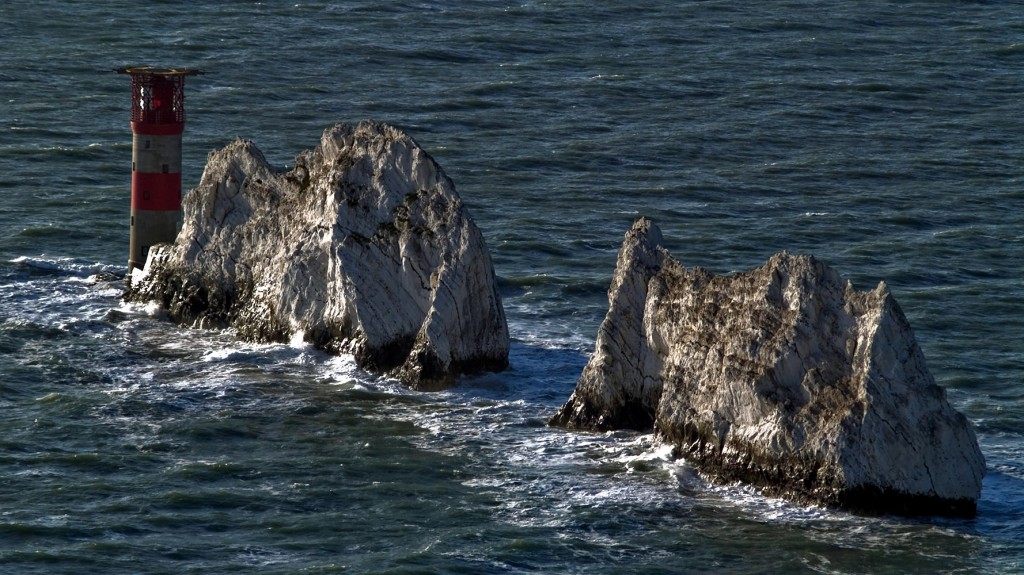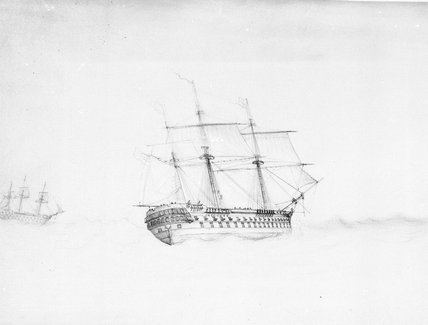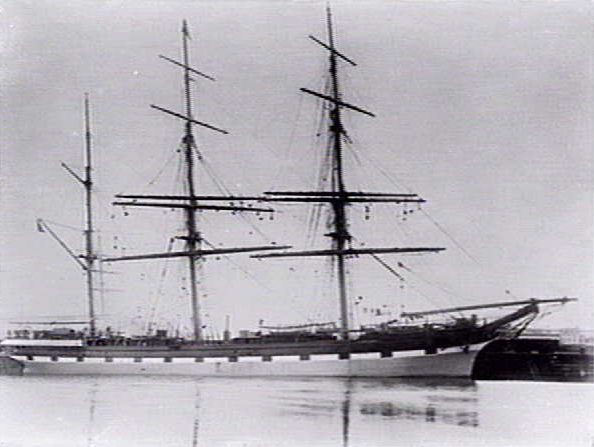
Some of the wrecks listed in this edition of Today’s Shipwrecks™ have been found, at least one was raised, but others are still undiscovered. What does it actually mean when reports say a ship was driven ashore? That is important because that was the fate of several ships on today’s list, which probably carried valuable merchandise and/or money. Can you guess which? If you are seeing this in a post, other than on Shipwrecks.com, read more about these wrecks and other ships lost on an April 24 at http://shipwrecks.com/shipwrecks-of-april-24/.
Today’s Shipwrecks™
April 24
compiled and edited by Dr. E. Lee Spence
1753: HMS Assurance, Captain Carr Scrope, was wrecked at the Needles (rocks) on the Isle of Wight, England on April 24, 1753. The ship remained stuck on the rock long enough for the crew and passengers to escape.
The Assurance was launched in 1747 and was a 44-gun fifth rate frigate of the Royal Navy. During this time period, fifth rate frigates were small two-deckers that usually had a full battery on two decks. Tonnage ranged from 700 to 1450 tons, with crews of 215 to 294 men. To be posted aboard a fifth-rate ship was considered an attractive assignment, as they were often assigned to interdict enemy commerce – meaning the prospect of prize money for the crew.
A shipwreck site at the Needles, which includes cannons and other metallic items thought to be from two wrecks, the Assurance and the Pomone (lost in 1818), was found and reported by Isle of Wight resident, Derek Williams. And, on April 4, 1974 the site was officially designated a protected site under the Protection of Wrecks Act and Williams became the site’s first licensee.
1772: Captain Farquhar, of the ship Hope, who arrived at New York from the Bay of Honduras, ran on the northwest part of the Bahama Bank on April 24, 1772, along with the ship Suffolk, Captain Jerman, and the sloop Polly. The Hope and the Polly soon got off. But, before Captain Jerman could get his ship afloat, he had to throw “overboard 40,000 feet of mahogany, 66 puncheons of rum, 17 hogsheads of sugar, etc., and put on board the Hope 44 casks of rum, six hogsheads of sugar, six bags of cotton, some sails and a cable; and on board the Polly, 20 puncheons of rum, and 17 bags of cotton. The Suffolk afterwards proceeded on her voyage.” A subsequent account adds a hawser and gun carriages to the list of items thrown overboard. Obviously there could have been more.
Note by ELS: Such groundings and subsequent escapes were not unusual, and may explain why anchors, cannons and other artifacts are frequently found in the shallows or on reefs, but no significant ballast pile indicating an actual shipwreck. I once dove on four large piles of cannon balls and a few pieces of iron ballast (collectively weighing many tons) on a shoal off the Dominican Republic. Although locals tried to tell me that it was the wreck of a French warship from the time of Napoleon, I seriously doubt that. The spacing between the piles and the depth of water, which was about 20’, combined with the lack of large brass “drift pins” and spikes, normally found at shipwreck site, led me to believe that the piles were the results of the successful efforts to free a large ship and keep her afloat. Because I also found the trunnion from a large cannon, of a caliber usually used in forts, rather than on board ships, I suspect that the vessel had simply been carrying a cargo of scrap iron, in the form of obsolete cannon balls. The fact that sea captain’s often threw valuable, but heavy, cargo overboard in an effort to save their vessel and the lives of the crew, is one reason that I usually include grounded vessels in my list of shipwrecks, even when I am aware that they were got off.
1779: The American armed ships Notre Dame, Beaufort, and Bellona intercepted two British supply vessels headed for Savannah, Georgia, on April 24, 1779, and blew-up a third.
1797: While heading to a new position in the Swin Channel, the Albion, which had been serving as a 60-gun floating battery in the Thames Estuary for the previous three years, ran aground. Two days later, during salvage efforts, her back broke, and she was completely wrecked. Her date of loss was listed as April 24, 1797.
HMS Albion had been built as a 74-gun third-rate ship of the line of 1,662 tons and 168 feet on her gun-deck. She was launched on 16 May 1763 at Deptford, being adapted from a design of the old 90-gun ship Neptune, which had been built in 1730, and was the first Royal Navy ship to bear the Albion. She was the first of a series of ships built to the same lines, which became known as the Albion-class ship of the line. As a 74 gun she she was originally armed with twenty-eight 32-pounders on her gun-deck, twenty-eight 18-pounders on her upper gun-deck, fourteen 9-pounders on her quarterdeck and four 9-pounders on her forecastle. Upon her conversion to a floating battery in 1794, she was armed with heavy carronades.
1808: On April 24, 1808, HMS Grasshopper, 18 guns, commanded by Thomas Searle, and HMS Rapid, 14 guns, commanded by Lt. Henry Baugh, captured two merchantmen and two escorting gunboats and drove two other gunboats ashore at Faro, Portugal. The Grasshopper was badly damaged in the fighting that day and had one man mortally wounded and three others slightly wounded. In 1847 the Admiralty awarded the Naval General Service Medal with clasp “Off Rota 4 April 1808” to all surviving claimants from the action.
Note: A vessel is commonly described as “on shore” or “ashore” whenever it has been stranded on a reef or shoal and there is insufficient water to get her off. It rarely means the vessel is actually high and dry, although that is sometimes the case due to storm tides carrying them above the normal high tide mark. Depending on the vessel’s draft and the slope of the seafloor, a vessel described as “ashore” may actually be well over a mile from the nearest land.
1839: The brig Champion, bound from Boston for Havana, was totally lost on Royal Island in the Bahamas on April 24, 1839. Her crew was saved.
1841: The brig Corinthian, of Gardiner, Maine, bound from Philadelphia for New Orleans, which was “wrecked on the shoal of the Great Bahama Banks in lat. 24°27’, was fallen in with 24th April (1841) and crew taken off by steam-barque Clarion.”
1850: The British brig Jewess, for New Orleans, from Spain, went ashore “on Crab Island” on April 24, 1850, and was expected to be a total loss.
1857: On April 24, 1857, the captain of the bark Dudley saw a bark with a white poop ashore “at Orange Key” and a brig with painted ports ashore “on the Key.” Two wreckers were alongside the vessels.
1863: The prize schooner Clune, of Nassau, went ashore near the breakwater on Lewes Beach, Delaware, on April 24, 1863, and went to pieces, all hands were saved.
1865: The United States steamer Oliver M. Pettit, Captain Smith, struck a snag or a sunken flat opposite the wreck of the steamer General Lee at Williamson’s Landing on the Savannah River on April 24, 1865, and sank. The officers and crew saved themselves in the ship’s boats.
A court of inquiry held on May 6, 1865, cleared the Pettit’s officers and crew of any blame for her loss. It was originally considered doubtful that she could be raised. However, the Pettit was later reported as raised and sold at Bay Point, South Carolina, for $8,200 on September 2, 1865.
1899: It was during the early hours of April 24, 1899, when the Scottish sailing barque Loch Sloy, Captain Peter Nicol, bound from Glasgow to Adelaide and Melbourne with a general cargo, met with disaster on the coast of Kangaroo Island at the mouth of the Investigator Strait, South Australia. The barque, with a crew of 26 and 7 passengers (2 of whom were women), had overrun her mark when trying to spot the light at Cape Borda. She was too close inshore and the light was hidden by the cliffs between Cape Bedout and Cape Couedie. In the darkness of the morning she ran full on to a reef known as Brothers Rocks about 300 yards from shore to the north of the Casuarina Islets in Maurpetuis Bay.
The Loch Sloy’s crew and passengers took refuge in the rigging, but one by one the masts broke and went over the side and all were hurled into the breakers. There was little opportunity for anyone to save themselves. The ship had struck well off shore and only four men reached the beach – a passenger, two able seamen and an apprentice. One of those who made it to shore, soon died from his injuries and exposure. None of the survivors could later say exactly how they got to safety; they heard the crash of the masts, and the next thing they were aware of was the wreckage bumping about them in the surf.
The Loch Sloy was built in Glasgow, Scotland, in 1877. She was 1,280 tons and measured 222 feet 4 inches in length (68.68 meters); 35 feet 5 inches (10.8 meters) in breadth, and 21 feet 2 inches (6.45 meters) in depth of hold.
1916: On the evening of April 23, 1916, the Imperial German submarine UB-13, commanded by Arthur Metz, departed Zeebrugge for a patrol off the mouth of the Thames and was never heard from again. Author Dwight Messimer, in his book Verschollen: World War I U-boat Losses, reports that the British had deployed a new explosive anti-submarine net in latitude 51°33′ north, longitude 2°45′ East in the early morning hours of April 24. Messimer suggests it was possible that UB-13 had set off some of the contact mines on the net, or that the submarine had struck a mine in one of the many British minefields off the Flemish coast. However, according to authors R. H. Gibson and Maurice Prendergast, in their book The German Submarine War, 1914–1918, UB-13 fouled the anchor cable of the British naval drifter Gleaner of the Sea on April 24, and was depth charged. Then for good measure, the British destroyer Afridi deployed explosive sweeps against the submarine. Regardless of the specific cause of her loss, she never returned from her voyage and its presumed all seventeen crewmen on board the submarine perished.
UB-13 was ordered in October 1914 and was laid down at the AG Weser shipyard in Bremen in November. UB-13 was a little under 92 feet (28 meters) in length and displaced between 127 and 141 tonnes (125 and 139 long tons), depending on whether surfaced or submerged. She carried two torpedoes for her two 17.7 inch bow torpedo tubes and was also armed with a deck-mounted 8 mm machine gun. UB-13 was broken into sections and shipped by rail to Antwerp for reassembly. She was launched in March 1915 and commissioned as SM UB-13 in April. During her career she sank eleven ships and captured another.
1917: The British steamship Lena, bound from Huelva, Spain, to Bristol, England with a cargo of government stores, was torpedoed and sunk southwest of the Scillies by the German submarine U-61 on April 24, 1917. Her cargo included 1,000 tons of lead bars, 2,700 tons of pyrites, and quite likely a shipment of silver bullion.
The Lena was built by Craig, Taylor & Company, at Stockton-on-Tees in northeast England in 1904, and was 2,463 tons, and about 306’4″ in length, 44 feet in breadth and 20 feet in depth of hull. She had a compound, three cylinder engine of 236 nominal horsepower.
1918: The British cargo ship Agnete was torpedoed and sunk on April 24, 1917, with the loss of twelve of her crew in the English Channel four nautical miles south by west of Start Point, Devon, England, by an Imperial German submarine.
1940: On April 24, 1917, the British cargo ship Stokesley struck a mine and sank in the Thames Estuary north of Birchington, Kent, England, with the loss of 15 crew.
1942: The British cargo ship Empire Drum was loaded with a cargo of 6,100 tons of military stores, including a quantity of tires and 1,290 tons of explosives when she was lost on April 24, 1942. She had departed from New York the day before bound for Alexandria, Egypt via Cape Town, South Africa. At 23:48 (German time) on April 24, German submarine U-136, under the command of Heinrich Zimmerman, fired two torpedoes at Empire Drum, which was then 280 nautical miles south east of New York in latitude 37°00′ North, longitude 69°15′ West. One of them hit in her No. 1 hold on the port side, causing her to sink by the bow. Due to the nature of her cargo, all 35 crew and six DEMS gunners immediately abandoned ship and took to the four lifeboats. At 00:08 on 25 April, U-136 fired a coup de grâce which hit amidships on the port side. Empire Drum quickly sank but the explosion wrecked one lifeboat, throwing its four occupants into the sea. They were rescued by one of the other lifeboats. U-136 surfaced and the survivors on board one of the lifeboats were questioned before the submarine left the scene.
The sea conditions were slight, with a good breeze blowing. At daybreak the lifeboats headed west. One lifeboat, containing the captain and 13 crew was spotted by the Swedish merchant ship Venezia on 26 April. The survivors rescued by Venezia were landed at New York the next day. The survivors on board second lifeboat, containing the chief officer and 13 crew were rescued by USS Roper on 29 April, having been spotted at 37°47?N 71°28?W by an aircraft. The survivors on board the third lifeboat were rescued by USS Roper on May 1. They were just 15 nautical miles off the coast of the United States, having sailed for 265 nautical miles. Those rescued by USS Roper were landed at Norfolk, Virginia on May 1, 1942.
The Empire Drum was a new vessel having been launched the previous November by William Doxford & Sons Ltd, Sunderland, United Kingdom, and completed in March 1942. She was yard number 684. She was 429 feet in length, with a breadth of 56 feet. She was assessed at 7,244 gross tons and her deadweight tonnage was 10,282. She was propelled by a 516nominal horsepower diesel engine, which could propel her at 11.5 knots.
1945: There were over 100 vessels sunk, bombed, scuttled or otherwise destroyed due to war related causes on April 24, 1945. I will include them in a future post.
• • •
NOTE: This is by no means meant to be a complete list of the vessels lost on April 24, as there have been thousands of ships lost for every day of the year. All of the above entries have been edited (shortened) and come from various editions of Spence’s List™. The original lists usually give additional data and sources. Those lists are being updated and are or will be made available for a fee elsewhere on this site.
© 2013, 2017, 2018 by Dr. E. Lee Spence for composition, content and compilation.
Share


